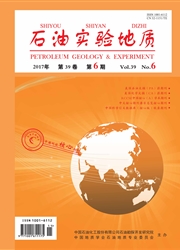

 中文摘要:
中文摘要:
选取济阳坳陷古近系渐新统沙河街组泥质烃源岩,进行小于2μm的粘土组分提取,运用红外发射光谱技术研究粘土矿物结合有机质的热演化过程和有机—粘土相互作用对有机质热演化过程的影响。结果显示,代表脂肪链结构的甲基、亚甲基振动吸收峰随着温度的升高,强度逐渐降低,烷基链由于受到粘土保护而晚于支链分解;代表芳香结构的芳环的振动吸收峰强度变化较为复杂,798,779,750 cm-1等峰随温度升高而减弱,而1 600 cm-1和3 030 cm-1峰则在200℃左右才出现并不断增强,随后慢慢减弱,且芳香度指数一直增加,显示出明显的芳构化过程。同时,粘土矿物层间水合阳离子通过"水桥"机制将含羧基的有机分子结合起来,对其演化有抑制作用。红外发射光谱研究揭示出粘土矿物结合的有机质主要通过脂肪族化合物的芳构化转化实现生烃的演化特征,是烃源岩热演化研究的有效手段。
 英文摘要:
英文摘要:
To examine the thermal evolution of and the influence of organo-clay interaction on organic matter bound by clay minerals in muddy source rocks, we studied the 〈2 μm particle-size fractions extracted from hydrocarbon source rocks in Neocene, Jiyang Depression, eastern China, using infra-red emission spectroscopy (IES). Results show that the vibration peaks of methylene and methyl representing aliphatic chain decrease with the increasing of temperature, and lateral chains are easily to subject to oxidation than main chains. Intensities of vibra- tion peaks attributed to aromatic compounds vary respectively, some peaks such as 798,779 and 750 cm-1 decrease with the increasing of temperature, but the reverse to other peaks. Vibration peaks such as 1 600 and 3 030 cm-1 do not occur until 250 ℃ and increase first and decrease subsequently, while aromaticity factor increases progres- sively, showing a clear aromatization process. Also, carboxylic acids interact with interlayer hydrated actions of clay minerals through hydrogen bond, making carboxylic acids much stabile and thus suppressing their thermal evolution. IES study reveals that organic matter bound by clay minerals generates hydrocarbon mainly through aromatization of aliphatic compound, which is a quite useful method for source rocks thermal evolution study.
 同期刊论文项目
同期刊论文项目
 同项目期刊论文
同项目期刊论文
 Formation and influencing factors of carbonate source rock of the Lower Permian Chihsia Formation in
Formation and influencing factors of carbonate source rock of the Lower Permian Chihsia Formation in 期刊信息
期刊信息
